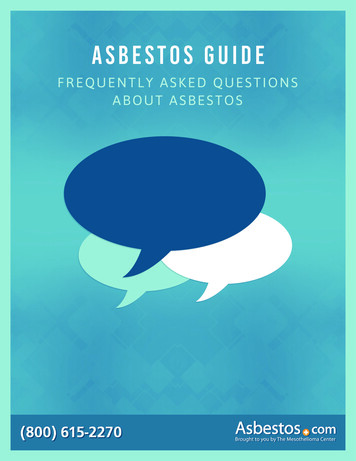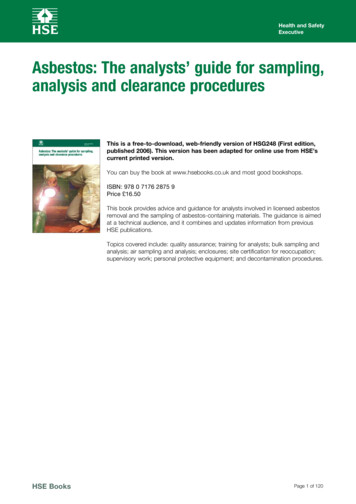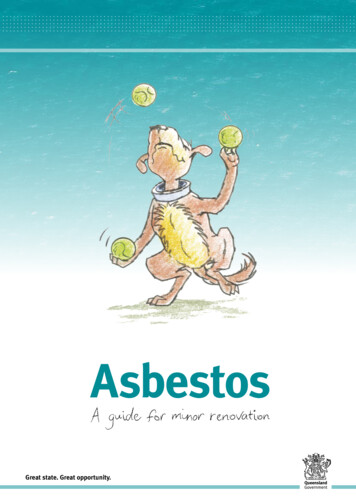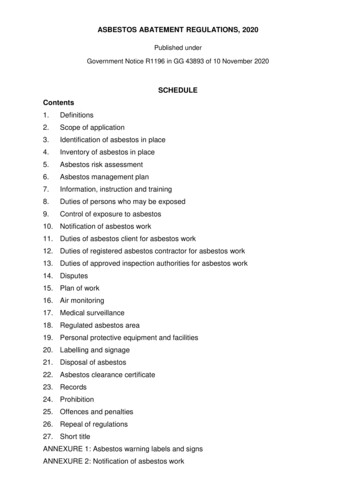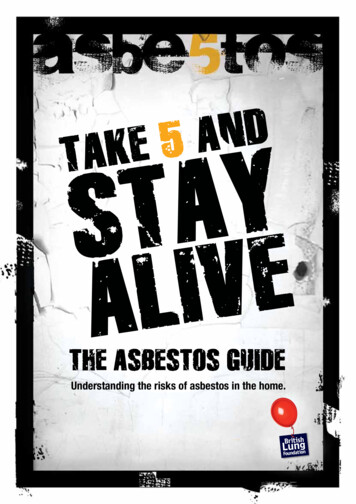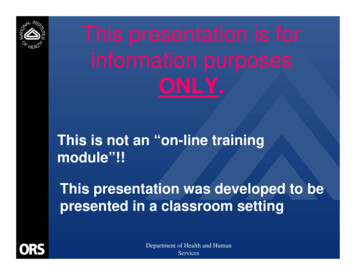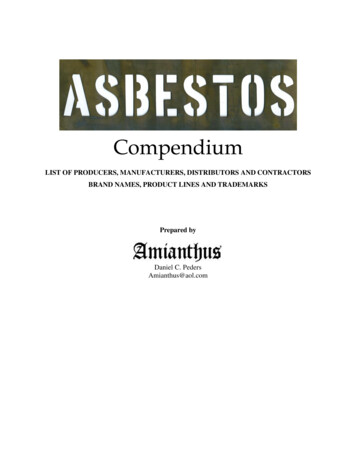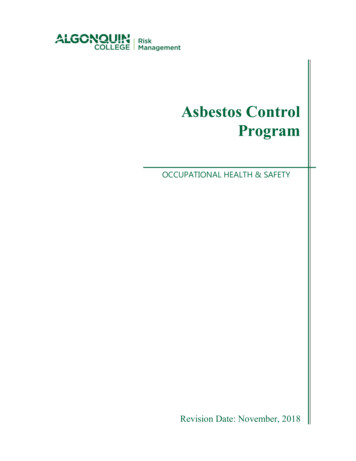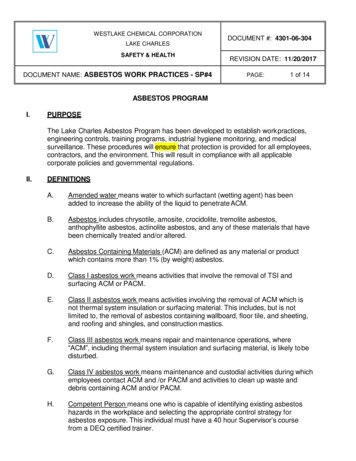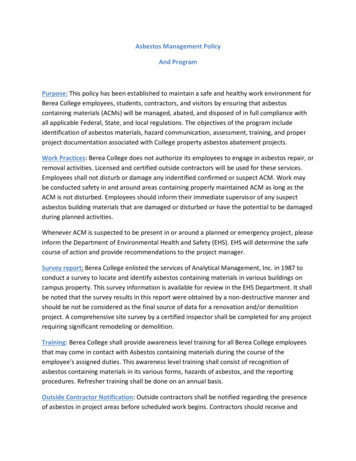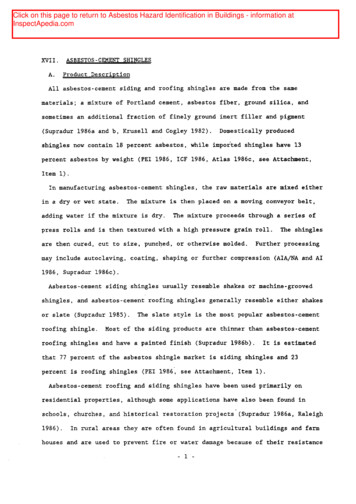
Transcription
Click on this page to return to Asbestos Hazard Identification in Buildings - information atInspectApedia.comXVII.A.ASBESTOS-CEMENT SHINGLESProduct DescriptionAll asbestos-cement siding and roofing shingles are made from the samematerials; a mixture of Portland cement, asbestos fiber, ground silica, andsometimes an additional fraction of finely ground inert filler and pigment(Supradur 1986a and b, Krusell and Cogley 1982).Domestically producedshingles now contain 18 percent asbestos, while impor:ted shingles have 13percent asbestos by weight (PEI 1986, ICF 1986, Atlas l986c, see Attachment,Item 1).In manufacturing asbestos-cement shingles, the raw materials are mixed eitherin a dry or wet state.The mixture is then placed on a moving conveyor belt,adding water if the mixture is dry.The mixture proceeds through a series ofpress rolls and is then textured with a high pressure grain roll.are then cured, cut to size, punched, or otherwise molded.The shinglesFurther processingmay include autoclaving, coating, shaping or further compression (AlA/NA and Al1986, Supradur l986c).Asbestos-cement siding shingles usually resemble shakes or machine-groovedshingles, and asbestos-cement roofing shingles generally resemble either shakesor slate (Supradur 1985).roofing shingle.The slate style is the most popular asbestos-cementMost of the siding products are thinner than asbestos-cementroofing shingles and have a painted finish (Supradur 1986b).It is estimatedthat 77 percent of the asbestos shingle market is siding shingles and 23percent is roofing shingles (PEI 1986, see Attachment, Item 1).Asbestos-cement roofing and siding shingles have been used primarily onresidential properties, although some applications have also been found inschools, churches, and historical restoration projects (Supradur 1986a, Raleigh1986).In rural areas they are often found in agricultural buildings and farmhouses and are used to prevent fire or water damage because of their resistance-1-
to both (National Tile Roofing Manufacturer’s Association 1986, Raleigh 1986).Currently, asbestos-cement roofing shingles have relatively no use in newconstruction (Atlas 1986b) and are principally being used for replacement andmaintenance in luxury homes, schools, churches, and historical restorations(Atlas 1986b, Supradur 1986a).For historical restoration they could be usedeither to preserve the historical integrity of a landmark that originally hadasbestos-cement shingles, or to replace real slate with a variety ofasbestos-cement shingles that resemble slate (Atlas 1986b; National RoofingContractor’s Association 1986).Asbestos-cement shingles are used mostly inthe Northeast and the Midwest and are generally not found in the West or South(National Tile Roofing Manufacturer’s Association 1986).B.Producers and Importers of Asbestos-Cement ShinglesIn 1981, there were three producers of asbestos-cement shingles:International Building Products, National Gypsum, and Supradur Manufacturing.National Gypsum stopped production prior to 1982 (TSCA 1982, ICF 1984).International Building Products closed their asbestos operations completely inMarch 1986, however it is not known when they last produced asbestos-cementshingles (Atlas l986a).Table 1 presents production data for the onlyremaining domestic producer of asbestos-cement roofing and siding shingles.The only known importer of asbestos-cement shingles is Atlas InternationalBuilding Products (AIEP) in Montreal, Quebec, Canada (Atlas 1986a and 1986b,Eternit 1986).C.TrendsDomestic production of asbestos-cement shingles for 1981 and 1985 arepresented in Table 2.While total domestic production of asbestos-cement-2-
Table 1.Production of Asbestos-Cement CF 1986.-3-176,643
Table 2.Production of Asbestos-Cement ShinglesYearNumber Sources:ICF 1986, TSCA 1982.-4-
shingles has declined 34 percent since 1981, Supradur’s production hasincreased 15 percent during this period (see Attachment, Item 3).It is not know how many asbestos-cement shingles are imported in the U.S.According to the Bureau of the Census, 10,416.3785 tons of asbestos-cementproducts other than pipe, tubes, and fittings were imported in 1985, of which8,489 tons, or 81.5 percent came from Canada (U.S. Dept. Comm. 1986a, 1986b).This number most likely includes flat and corrugated asbestos-cement sheet andasbestos-cement shingles.AIBP, the only importer of these products.fromCanada roughly estimated that 80 percent of their U.S. shipments areasbestos-cement shingles (Atlas l986a, Atlas 1987).Eighty percent of Canadianshipments, or 6,791 tons, converts to 64,654 squares of asbestos-cementshingles imported in 1985.D.SubstitutesTable 3 summarizes the primary substitutes for asbestos-cement siding androofing shingles.There are no substitutes for asbestos-cement shingles in themaintenance and repair market because there are no substitute products thatresemble the asbestos-cement product closely enough to be able to replace it inparts (National Roofing Contractor’s Association 1986, Supradur 1986b).Slateis the only shingle that would be close in appearance to some asbestos-cementshingles, but it is much thicker and far more expensive (Supradur 198Gb).Forour study, we will consider substitutes that can be used instead ofasbestos-cement shingles for complete remodeling or new construction.Thefollowing section presents separate discussions of substitutes forasbestos-cement siding shingles and asbestos-cement roofing shingles.1.Asbestos-Cement Siding Shingle SubstitutesThe three primary substitutes for asbestos-cement siding shingles arewood, aluminum, and vinyl siding.Wood siding includes hardboard siding and-5-
Over 450 in U.S. andCanada.U.S. Plywood,Stamford, CT;Weyerhaueser,Tacoma, WA; and morethan 10 othersCertain-Teed,Valley Forge, PA;Vipco, Coltnnbus, OH;and several othersAlcan Altaninizn,Warren, OH;Alcoa Building Products,Sidney, OH; and severalothersBardboard SidingVinyl SidingAluminum SidingManufacturerRed Cedar Shingles andHandsplit. ShakesSiding SubstitutesProduct SubstituteTable 3.Several colors.Lightweight.Corrosion resistant.Holds color well.No maintenance required.Stiffer than vinyl.Easy to cut and handle.Won’t peel, flake, blisteror corrode.Inexpensive.No maintenance required.More insulative than vinyland aluminum.Doesn’t dent easily asaluminum.Not as noisy as aluminum.Doesn’t expand and contract like vinyl.Doesn’t have knots likecedar wood.Relatively high strength/weight ratio.Effective insulator.Rigid.Wind resistant.Attractive.AdvantagesCan be dented.Cannot be painted.More expensive than vinyl.Can be dented, but not aseasily as aluminum.Can’t be painted.Color may fade over time.Expands and contracts withtemperature change.Can be brittle in coldweather.Available only in lightcolors.Flexible.Absorbs moisture.Requires protective paint.Doesn’t have longevity ofvinyl and aluminum.More expensive to install.Non fire-resistant.Usually requires stain orprotective coating.DisadvantagesProduct Substitutes for Asbestos-Cement tyAlcoa 1986a, b,Comonwealth Aluminum1986Certain-Teed 1986,Cciisnonwealth Aluminum1986, Alcoa 1986a, bWeyerhaeuser 1986,American HomeImprovement 1986Red Cedar Shingles andHandaplit Shake Bureau1986b, Chemco 1986bReferences
AmericanMission,and overin B.C.,Monier, Orange, CA;Ludowici-Celadon,New Lexington, OH;U.S. Tile, Corona, CA;and several othersCedar Wood Shinglesand ShakesTire, Concrete andClayWood Treating,B.C., Canada450 other millsWA, OR and IDManville Sales,Denver,CO;O cens-Corning,Toledo, OH;GAP, NY, NY;Georgia Pacific,Atlanta, GA; andseveral othersManufacturerAsphalt Fiberglass andOrganicRoofing SubstitutesProduct SubstituteDurable.Wind and weather resistant.Incotthustible.Insulative.Relatively high strength!weight ratio.Effective insulator.Rigid.Wind resistant.Attractive.Fire resistant.Weather resistant.Wind resistant.Low cost.Easy application.LightweightAdvantagesTable 3 (Continued)Heavy.Expensive to install.Not as fire resistant asother products.Fiberglass shingles.May be brittle.Shorter life.Tendency to abilityNational Tile RoofingManufacturer’s Association (n.d.),Means 1986Red Cedar Shingle andHandsplit Shake Bureau1985Asphalt RoofingManufacturer’s Association 1981, NationalRoofing Contractor’sAssociation 1986,ICF 1984References
red cedar shakes and shingles1 with a small amount of redwood or cedarpaneling.Hardboard is the most common wood siding product, comprising 69percent of the wood siding category (American Hardboard Association 1986a, RedCedar Shingle & Handsplit Shake Bureau 198Gb, see Attachment, Item 4).Hardboard is made by mixing wood fiber (90 percent) with phenolic resin (10percent) and compressing them under high pressure.Usually a wood grain isembossed onto the board to make it resemble redwood or cedar; it can also havea stucco or shake appearance.Hardboard comes in two main sizes:which are 1 foot by 16 feet and boards which are 4 by 8 feet.thicknesses varying from 7/16 to 1/4 inch.lap panelsBoth come inHardboard has a national market,although in the South and the Southwest brick and stucco, respectively, arepreferred (Weyerhaeuser 1986).There are about 10 major manufacturers ofhardboard siding including U.S. Plywood, Stamford, CT; Weyerhaueser, KalainathFalls, OR; Masonite, Laurel, MS; and Georgia-Pacific, Atlanta, GA (Weyerhaueser1986).Red cedar siding shakes and shingles comprise the remaining 31 percent of thewood siding category (American Hardboard Association l98Ga, Red Cedar Shingle &Handsplit Shake Bureau 198Gb, see Attachment, Item 4).Over 90 percent ofcedar siding is used in the Northeast, particularly New England.Red cedar isan effective insulator because its cellular structure retards the passage ofheat and cold through the wood (Red Cedar Shingle & Handsplit Shake Bureau1986b).Cedar siding is usually stained by users although the stains areusually flammable and make the product much less flame resistant.Vinyl siding has been one of the largest growing siding products and canespecially substitute for asbestos-cement shingles in residential areas.It1 Shingles are sawed on both surfaces, whereas shakes have at least onesplit surface and thus present a rugged, irregular texture (Red Cedar Shingleand Handsplit Shake Bureau l986a).-8-
competes mostly with aluminum siding.Vinyl has taken a larger share of thesiding market in the past few years, thereby reducing aluminum’s share.Bothaluminum and vinyl siding often have a simulated wood-grain finish and areavailable in several colors.One major problem with vinyl is its tendency toexpand and contract with changes in temperature.In hot weather vinyl sidingmay expand and come loose from the exterior wall.In order to minimize thisexpansion problem, vinyl siding is only available in light colors that do notabsorb as much heat (Alcoa 198Gb, Commonwealth Aluminum 1986).Major producersof vinyl siding include Certain-Teed, Valley Forge, PA; Vipco Inc., Columbus,OH; Mastic Corp., South Bend, IN; Wolverine, Lincoln Park, MI; Bird Inc.,Bardstown, KY; Alcoa Building Products, Sidney, OH; and Alside, a division ofUSX Corporation (Certain-Teed 1986).Aluminum is a proven product and has been available for over 30 years, longerthan vinyl siding.While aluminum is more temperature resistant than vinyl, itdents much more easily than other siding products (Commonwealth Aluminum 1986,Certain-Teed 1986).Though metal, aluminum siding resists rusting by forming aprotective oxide coating (Commonwealth Aluminum 1986).Three major producersof aluminum siding are Alcan Aluminum in Warren, OH, Alcoa Building Products inSidney, OH, and Reynolds in Richmond, VA.Both Reynolds ‘and Alcoa also producevinyl siding.Painted steel, stucco, masonry, brick, and concrete blocks may also be usedas siding, but they will not be significant substitutes for asbestos-cementsiding shingles (Commonwealth Aluminum 1986, Krusell and Cogley 1982, AmericanHardboard Association 198Gb).2.Asbestos-Cement Roofing Shingle SubstitutesThe primary substitutes for asbestos-cement roofing shingles are asphaltshingles (fiberglass or organic), cedar wood shingles, and tile (concrete orclay).Asphalt shingles are the most competitive asbestos-cement roofing-9-
shingles substitute, even though they have a shorter service life than othersubstitutes (National Roofing Contractor’s Association 1986).most asphalt shingles had an organic or wood-pulp base.Before 1960,Today, however, 83percent of standard strip asphalt shingles have a fiberglass base.All asphaltshingles are fire resistant (fiberglass-asphalt shingles have a Class A firerating, the highest fire rating available; organic-asphalt shingles have aClass C fire rating, which is a lower rating than Class A, but still somewhatfire resistant).Fiberglass-asphalt have slightly less bulk and are lighterweight than the organic-asphalt shingles (Asphalt Roofing Manufacturer’sAssociation 1984).Some contractor’s prefer the organic- asphalt because theyhave a longer proven track record than fiberglass-asphalt shingles and some ofthe very light weight arid cheaper fiberglass-based shingles are very brittle;however, many feel that this problem has been resolved by the manufacturers(Qualified Remodeler Magazine 1986, RSI 1986a).There are over 20 domesticmanufacturers of asphal shingles including Owens-Corning Fiberglas, GAF,Georgia Pacific, and Lu iday-Thagard (Owens-Corning Fiberglas 1986, AsphaltRoofing Manufacturer’s Association 1981).Although not as fire esistant,red cedar wood shingles and shakes arepopular roofing substit ites. Cedar shingles are made in the Northwest and inBritish Columbia, Cana4 by over 450 mills; however, some of these arevirtually one man operations (Red Cedar Shingle & Handsplit Shake Bureau 1985).Ninety-five percent of anadianproduction is shipped to the U.S. and accountsfor 70 percent of U.S. cllomestic consumption (Red Cedar Shingle & Handsplit’Shake Bureau l986a).R dcedar shingles and shakes are distributed across theU.S., the highest concet itrationbeing in California, Washington, Oregon, andTexas (Red Cedar Shingle & Handsplit Shake Bureau 1986b).Only 15 to 30percent of cedar roofing shingles and shakes are fire resistant, with a firerating of either Class B or Class C.Because of the fire hazard posed by10-
non-fire resistant cedar roofing shingles, some California towns have outlawedtheir use (RSI l986b, American Wood Treating 1986, Chemco l986a and b).Approximately 72,000,000 squares of asphalt fiberglass and organic stripshingles were produced in 1985 (Asphalt Roofing Manufacturer’s Association1986, see Attachment, Item 6).The tile roofing market is about the same size as the cedar roofing market,each of which are less than one-tenth the size of the asphalt roofing shinglemarket (National Tile Roofing Manufacturers Association 1986, Red Ce4ar Shingleand Handsplit Shake bureau 1986a, Asphalt Roofing Manufacturers Association1986).Concrete comprises 90 percent of the tile market and clay holds theremaining 10 percent (National Tile Roofing Manufacturer’s Association 1986).Tile is used primarily in the Sunbelt- -Florida, California, and the South(Raleigh 1986, National Tile Roofing Manufacturer’s Association 1986).It isvery insulative because the air space between the tile and the underlaymentcreates a heat flow barrier (National Tile Roofing Manufacturer’s Association(n.d.)).Tile is available in three main styles:(shakes or slate-like).s-tile, mission, and flatThere are more than 13 U.S. concrete tilemanufacturers; the largest in the U.S. and the world is Monier Roof Tile inOrange, CA (Monier 1986a, National Tile Roofing Manufacturer’s Association(n.d.)).The four clay roof tile manufacturer’s, all located near claydeposits, are Ludowici-Celadon, New Lexington, OH,; U.S. Tile, San Valle, andMCA in Corona, CA (National Tile Roofing Manufacturer’s Association 1986).Slate is very expensive and has a very small share of the roofing market.Itis primarily used in the Vermont and New York area, the two states where it isquarried.The cost of asbestos-cement shingles and substitute roofing and sidingproducts are compared in Table 4.-11-
12010612811350636350651813016210953Wood Siding cand Roofinginto one wood roofing/siding category for which price and market share are determined (see Attachment, Item 11 forcalculations).CIn order to simplify the number of inputs for the asbestos regulatory cost model, wood siding and wood roofing are combinedbWood siding includes harcthoard and cedar shingles and shakes (see text).(see text).16350206717311063Tile Roofing493019AsphaltRoofing ShinglesWood roofing includes only cedar shingles and shakesAluminum Siding50Vinyl SidingCost of A/C Shingles and SubstitutesaaSee Attachuent, Items 8-13 for equations used to determine costs.11340Operating Life (years)Present Value (5/square)11348Installation Cost (S/square)Total Cost (S/square)65FOB Plant Cost (S/square)A/C ShinglesTable 4.
Siding.overall.2Wood siding is the most expensive asbestos-cement siding substituteAsbestos-cement shingles, vinyl siding, and aluminum siding areclose in overall price.The substitute market for asbestos-cement siding shingles is divided amongwood (hardboard and cedar shakes and shingles), 40 percent; vinyl, 35 percent;and aluminum, 25 percent (see Attachment, Items 4-5).Roofing.Table 4 shows that asphalt roofing shingles, the most popularsubstitute for asbestos-cement roofing shingles, are also the least expensiveoverall, even though they have half the service life.Both tile and cedarshingles and shake roofing are more than double the cost of asphalt roofing(see Attachment, Items 11-14).The current market share for substitute roofing shingles, based on 1985production, is asphalt shingles (primarily asphalt-fiberglass), 86 percent,with tile (primarily concrete) and cedar wood shingles each taking 7 percent(see Attachment, Item 6).Asphalt-fiberglass shingles has been and continuesto be the fastest growing segment of the roofing market, while cedar roofingshingle and shake production has declined since 1983 (Red Cedar Shingle &Handsplit Shake Bureau l986b).Because the domestic asbestos-cement shingle market is 77 percent siding and23 percent roofing (PEI 1986), the combined roofing and siding replacementmarket for asbestos-cement shingles would probably breakdown as follows (seeAttachment, Items 4-7):2 For the asbestos regulatory cost model, in order to simplify the numberof inputs, wood siding and wood roofing are combined into one wood roofing/siding category for which price and market share are determined (seeAttachment, Item 4-7, 11).‘-13-
Proj ectedMarket jTotal100Table 5 presents the data for the asbestos regulatory cost model andsummarizes the findings of this analysis.E. SummaryAsbestos-cement siding shingles resemble shakes or machine-grooved shinglesand asbestos-cement roofing shingles generally resemble either shakes or slate(Supradur 1985).They are primarily being used for replacement and maintenancein luxury homes, schools, churches, and historical restoration projects (Atlas1986b, Supradur 1986a).Of three domestic producers in 1981, only one,Supradur, remains in 1986.Production has declined 34 percent from 266,670squares in 1981 to 176,643 squares in 1985 (ICF 1986, TSCA 1982).Only onecompany, Atlas International Building Products (AIBP) of Montreal, Quebec,Canada is known to import asbestos-cement shingles into the U.S. (Atlas l98Ga,Atlas l986c).There are no substitutes for asbestos-cement shingles for maintenance andrepair applications because no substitute products resemble the asbestosproduct closely enough to replace it in part (National Roofing Contractor’sAssociation 1986, Supradur 1986b).However, there are many adequatesubstitutes that can be used for complete replacement, remodeling or in newconstruction.The replacement market is as follows:-14-wood siding and roofing,
N/AN/AN/AN/AVinyl SidingAsphalt Roofing ShinglesAluminum SidingTile RoofingN/AN/AN/AN/AN/A0.022ProductAsbestos CoefficientN/AN/AN/AN/AN/A1.37Consumpt ionProduction Ratio 173.00 128.0050 years50 years20 years 49.0050 years30 years40 yearsUseful Lifea 113.00 162.00 113.00Price(S/square)Data Inputs for Asbestos Regulatory Cost ModelSee Attachment, Items 4-16 for explanation and calculations.5Not Applicable.N/AWood Siding and RoofingN/A:176,643 Output(squares)Asbestos-Cement ShinglesProductTable 5.61.66. 167.12 123.65 109.16 174.05 rketShareSee AttachmentSee AttachmentSee AttachmentSee AttachmentSee AttachmentSee AttachmentReference
32 percent; vinyl siding, 27 percent; asphalt-based roofing, 20 percent;aluminum siding, 19 percent; and tile roofing, 2 percent.siding cost about the same as the asbestos product.Vinyl and aluminumAsphalt-based roofingshingles are about half the cost, and tile roofing and wood siding and roofingare 45-GO percent more expensive than asbestos-cement shingles.-16-
ATTACHMENT(1)Calculation of percent of asbestos in domestic asbestos-cement shingles.One domestic producer has a production capacity of 134,800 squares or12,000 tons for siding shingles and 40,000 squares or 9,500 tons for roofingshingles (PEI 1986). This gives an average weight of 178 lbs./square ((12,000tons x 2,000 lbs./ton)/(134,800 squares)) for siding shingles and 475lbs./square ((9,500 tons x 2,000 lbs./ton)/(40,000 squares)) for roofingshingles. This yields a roofing and siding shingle weighted average weight of246 lbs./square ((134,800 squares x 178 lbs./square . 40,000 squares x 475lbs./ square)/l74,800 squares). The domestic producer’s shingles have anaverage of 44 lbs. of asbestos per square. Therefore, ((44 lbs. ofasbestos/square)/246 lbs./square) x 100 — 17.89 percent or 18 percent asbestosby weight in asbestos-cement domestic shingles.From the production capacities in squares shown above, it is estimatedthat 77 percent of the asbestos-cement shingle market is siding and 23 percentis roofing.(2)Calculation for imports of asbestos-cement shingles.10,416.3785 tons of asbestos-cement flat and corrugated sheet andasbestos-cement shingles were imported into the U.S. in 1985. 81.5 percent, or8,489 tons, of this figure was from Canada. Atlas International BuildingProducts (AIBP), the only importer of these products from Canada estimates that80 percent of their imports is asbestos-cement shingles (Atlas l986a). Tenpercent equals 6,791 tons or 13,582,000 lbs. of asbestos-cement shingles.AIBP estimates that 60 percent of the asbestos-cement shingles importsare siding and 40 percent are roofing shingles:SidingRoofing 0.6 x (6,791 tons)0.4 x (6,791 tons)——4,075 tons2,716 tons——8,150,000 lbs.5,432,960 lbs.AIBP’s siding and roofing shingles weigh 155 lbs./square and 450lbs /square, respectively.Siding Shingles—(8,150,000 lbs.)/(455 lbs./square)52,581 squares(5,432,960 lbs.)/(450 lbs./square)—12,073 squares—64,654 squares——Roofing ShinglesTotal ImportsThis estimate may be low because it does not include the 18.5 percent ofasbestos-cement products other than pipe, tubes, and fittings imported fromcountries other than Canada. These imports from other ‘countries may possiblyinclude some flat asbestos-cement shingles (U.S. Dep. Comm. l986a, l986b).-17-
(3)Calculations for changes in production of asbestos-cement shinglesbetween 1981 and 1985 (TSCA 1982. ICF 1986 .(1985 production1981 production/l98l production) * 100(176,643 squares266,670 squares/26G,670 squares) * 100 -33.8% -34%.- -Domestic production has changed as follows:(1985 production1981 próduction/1981 production) * 100(176,643 squares153,603 squares/l53,603 squares) * 100 15%.- (4)-Calculations for the share of cedar shingle and hardboard in the woodsiding market.Members of the Red Cedar Shingle and Handsplit Shake bureau produced355,825 squares in 1985. Since this association accounts for only 70 percentof the cedar shingle and shake market, 355,825/0.70, or 508,321 red cedarshingles and shakes were produced in 1985 (Red Cedar Shingle and HandsplitShake Bureau 1986a and b). This combined with 1,128,992 squares of hardboardsiding produced in 1985 makes for a total of 1,637,313 squares (AmericanHardboard Association l986a and 1986b).(508,321/1,637,313) * 100(1,128,992/1,637,313) * 100——31% red cedar siding69% hardboard siding(5)Estimates of the projected market share for wood, vinyl, and aluminum inthe siding market were based on estimates from the following references:Qualified Remodeler Magazine 1986; Alcoa l986a and b; Contractor’s Guide1986.(6)Calculations of projected market shares in the asbestos-cement shinglesreplacement roofing market.—Asphalt fiberglass and organic standard strip shingles produced in 198571,766,672 (Asphalt Roofing Manufacturer’s Association 1986b).Members of the Red Cedar Shingle and Handsplit Shake Bureau produced3,885,174 squares of roofing shingles and shakes in 1985. Since thisassociation accounts for only 70 percent of the cedar shingle and shake market,3,885,174/0.70, or 5,550,249 squares of red cedar shingles and shakes forroofing were produced in 1985 (Red Cedar Shingle and Handsplit Shake Bureau1986a and b).About 6,000,000 squares. of tile roofing were produced in 1985 (NationalTile Roofing Manufacturer’s Association 1986).This makes a total of 83,316,921 squares consisting of 86.1 percentasphalt shingles, 6.7 percent wood, and 7.2 percent tile.-18-
(7)Calculation of total replacement market shares.The following calculations are based on the fact that 77 percent of theasbestos-cement shingle market is siding, and 23 percent is roofing (PEI 1986).Wood roofing 6.7% (0.23) and siding40.0% (0.77) 32.34% 32%Vinyl35.0% (0.77) — 26.95% — 27%Asphalt86.1% (0.23) — 19.80% — 20%Aluminum25.0% (0.77) — 19.25% — 19%Tile‘7.2% (0.23) 1.66% — 2%(8)Calculation of costs for asbestos-cement roofing and siding shingles.The asbestos-cement shingle F.O.B. plant cost is based on Supradur’saverage price according to an ICF survey (ICF 1986). The asbestos-cementshingle installation cost is a weighted average for 325 lb./square and 500lb./square roofing shingles and 167 lb./square siding shingles (Means 1986a).Roofing asbestos-cement shingle cost325 lb. 40/square500 lb. 73/squareAverage 56.50Siding asbestos-cement shingle cost 46/square for 167 lb./square (Means1986).Because 77 percent of asbestos-cement shingle market is siding and 23percent roofing,(56.50/square * 0.23) ( 46/square * 0.77) — 48.42 48 for installation of asbestos-cement shingles. (9)Cost of vinyl siding.The F.O.B. ‘plant cost for vinyl siding is based on the followingreferences: Alcoa 1986a and b; Certain-Teed 1986.The installation’ cost is for solid PVC panels 8”-lO” wide, plain orinsulated (Means 1986).(10)Cost of aluminum siding.The F.O.B. plant cost for aluminum siding is based on the followingreferences:Alcoa 1986a and b; Certain-Teed 1986.The installation cost for aluminum siding is the same as for PVC siding(American Home Improvement 1986; Wages and Evans 1986; Johnny B. Quick 1986).-19-
(11)Cost of wood siding and roofing.To determine the cost of wood siding and roofing, costs are firstderived separately for wood siding alone and wood roofing alone. These costsare then multiplied by their share of the asbestos-cement shingle replacementmarket to give a weighted average cost for wood roofing and siding.(a)Cost of wood siding.The F.O.B. plant price of cedar siding shingles and shakes is 80/square(American Wood Treating 1986). The F.O.B. plant price for hardboard woodsiding is 40/square (Weyerhaeuser 1986, U.S. Plywood 1986).Since the 69 percent of the wood siding replacement market forasbestos-cement shingles is hardboard and 31 percent is cedar shakes andshingles (see previous calculations), the average cost for all wood siding willbe( 80/square x 0.31) ( 40/square x 0.69) 52.40/square for wood siding The installation costs for cedar wood siding shingles and shakes areaveraged from Means 1986.16” long with 7-1/2” exposure —18” long with 7-1/2” exposure —18” long with 8-1/2” exposure —Average of these three — 76.33 78/square 71/square 80/squareor 76/squareThe installation costs for hardboard siding was estimated to be doublethat for aluminum and PVC, or 126/square. Even if this estimate is a bithigh, it will include the cost for painting that hardboard siding requires(American Home Improvement 1986, Moon Sidings 1986, National Home ImprovementCo. 1986).The weighted average cost for all wood siding is based on G9 percent ofthe replacement market being hardboard and 31 percent cedar siding (seeprevious calculations).( 126/square x 0.69) ( 76/square x 0.31)is the average installation cost for wood siding.— 110.50 or 111/squareThe operational life for wood siding is determined by taking a weightedaverage of that for hardboard and for cedar wood.Hardboard life—Cedar life—25 years (American Hardboard Association 1985,Weyerhaeuser 1986).40 years (ICF 1985).(40 years x 0.31) (25 years x 0.69)-20- 29.65 years 30 years
(b)Cost of wood roofing.The average estimated F.O.B. plant cost for non-fire treated cedarroofing shingles is 68/square (American Wood Treating 1986, RSI 1986, Chemco1986a).The installation cost is an average of 16” and 18” roofing shingles.16” — 64/square18” — 58/squareAverage — 61/square(c)Cost of wood siding and roofingThe wood roofing market represents 1.54 percent of the entireasbestos-cement shingle replacement market. The wood siding market represents30.80 percent of the entire asbestos-cement shingle replacement market for atotal market share of 32.34 percent for wood (see previous market sharecalculations). Therefore, roofing is ((1.54/32.34) x 100), or 4.8 percent ofthe w
remaining domestic producer of asbestos-cement roofing and siding shingles. The only known importer of asbestos-cement shingles is Atlas International Building Products (AIEP) in Montreal, Quebec, Canada (Atlas 1986a and 1986b, Eternit 1986). C. Trends Domestic production of asbestos-cement shingles for 1981 and 1985 are presented in Table 2.
